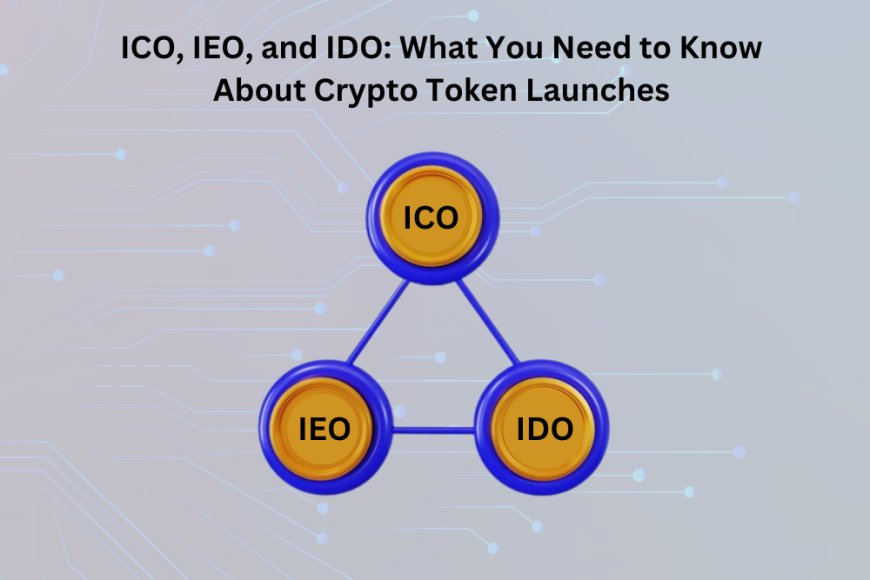ICO, IEO, and IDO: What You Need to Know About Crypto Token Launches
Learn about ICO, IEO, and IDO crypto token launches. Explore their differences, pros, cons, and how to choose the right strategy for your project.

In the world of cryptocurrency and blockchain, launching a new crypto token is a pivotal step in a project’s growth. However, this process is more complex than simply creating a token and selling it. To raise funds, engage investors, and build momentum, crypto projects typically turn to various token launch methods, such as Initial Coin Offerings (ICO), Initial Exchange Offerings (IEO), and Initial DEX Offerings (IDO). These methods allow projects to distribute their tokens to the public and raise the necessary capital for development.
If you're considering launching your own token, or if you're curious about how crypto projects bring new tokens to market, understanding the differences between ICO, IEO, and IDO is crucial. This guide will break down each of these methods, their pros and cons, and what you need to know about them.
What is Crypto Token Development?
Before diving into ICOs, IEOs, and IDOs, let’s first understand crypto token development. Token development is the process of creating digital tokens that represent assets, rights, or utilities on a blockchain. These tokens can serve different purposes, such as acting as a currency, offering governance rights, or representing an asset like real estate or art. Crypto tokens are usually built on existing blockchain networks like Ethereum or Binance Smart Chain (BSC).
The process of crypto token development includes several steps:
- Conceptualizing: Deciding the token’s purpose, whether for utility, security, or as a non-fungible token (NFT).
- Smart Contract Development: Writing the code that governs the token’s creation, distribution, and transactions.
- Testing and Deployment: Ensuring the token is secure and functional before launching it on the blockchain.
The role of a crypto token development company is to manage this entire process, ensuring the token aligns with the project’s goals and meets industry standards. Once the token is created, it’s time for the project to consider launching it via an ICO, IEO, or IDO.
What Is an ICO?
An Initial Coin Offering (ICO) is one of the earliest and most popular methods for raising funds in the cryptocurrency space. In an ICO, a project sells its tokens directly to investors in exchange for cryptocurrency (usually Bitcoin or Ethereum) or fiat money.
How ICO Works
-
Whitepaper: The project creates a whitepaper that outlines the goals of the project, how the token works, and how the raised funds will be used. The whitepaper serves as the foundation for the ICO.
-
Token Sale: Investors purchase tokens at a predetermined price during the ICO. The project often has a soft cap (minimum funding requirement) and a hard cap (maximum amount to be raised).
-
Token Distribution: Once the ICO ends, the tokens are distributed to investors’ wallets. These tokens can then be traded on exchanges once the project is listed.
Pros of ICOs
- Greater Control: The project has full control over the launch, including the token price and fundraising target.
- Wide Reach: ICOs allow projects to reach a global audience, as there are no centralized restrictions.
- Low Costs: There are fewer fees and administrative costs compared to IEOs and IDOs.
Cons of ICOs
- Regulatory Risks: Many ICOs have faced regulatory scrutiny because they are often seen as unregulated securities. This has made it difficult for some projects to launch in certain jurisdictions.
- Lack of Trust: ICOs have been associated with scams and fraud. This makes investors wary and less likely to participate in new ICOs.
- No Exchange Listing: Tokens sold in an ICO are not automatically listed on exchanges, meaning investors may face delays in trading them.
What Is an IEO?
An Initial Exchange Offering (IEO) is a more recent evolution of the ICO. In an IEO, the token sale is conducted through a cryptocurrency exchange rather than directly by the project. This means the exchange handles the sale, ensuring a more secure and regulated environment for both the project and investors.
How IEO Works
-
Partnership with an Exchange: The project partners with a crypto exchange to launch the IEO. The exchange will evaluate the project to ensure its credibility.
-
Token Sale: The exchange handles the sale, and investors buy tokens using the exchange’s platform. This provides an added layer of security for investors since exchanges have strong security measures in place.
-
Listing on the Exchange: After the IEO is complete, the tokens are immediately listed on the exchange, allowing investors to trade them.
Pros of IEOs
- Security and Trust: Since the exchange vets the project, investors often feel more confident in participating.
- Immediate Liquidity: Tokens sold through IEOs are typically listed on the exchange right after the sale ends, providing immediate liquidity.
- Regulatory Compliance: Exchanges are typically more compliant with local regulations, which adds a layer of legitimacy to the project.
Cons of IEOs
- Exchange Fees: Exchanges charge significant fees for hosting IEOs, which can be expensive for the project.
- Limited Reach: Only users on the specific exchange can participate in the IEO. This limits the potential investor pool.
- Exchange Control: The project has less control over the fundraising process, as the exchange handles most of the logistics.
What Is an IDO?
An Initial DEX Offering (IDO) is a token sale conducted on a decentralized exchange (DEX). This method is considered a more decentralized approach to launching a crypto token, as it does not involve a centralized exchange or intermediary.
How IDO Works
-
Token Launch on a DEX: The project lists its token on a decentralized exchange that supports IDOs, such as Uniswap or PancakeSwap.
-
Liquidity Pool: A liquidity pool is created, where users can buy the token directly using a decentralized wallet. The project may also offer token rewards to encourage liquidity providers.
-
Instant Listing: Since it’s a decentralized exchange, tokens are usually immediately available for trading after the IDO.
Pros of IDOs
- Lower Fees: IDOs typically involve lower fees compared to ICOs and IEOs since there’s no intermediary or exchange to pay.
- Decentralized: IDOs align with the decentralized ethos of blockchain, where there’s no central authority controlling the process.
- Immediate Trading: As soon as the IDO is complete, the token can be traded on the DEX.
Cons of IDOs
- Less Security: The decentralized nature of DEXs means that there’s less security compared to IEOs. Scams can still occur, and investors may be more vulnerable.
- Limited Support: There’s no central authority helping with the launch process. This can be challenging for projects with less experience in managing token sales.
- Gas Fees: On some blockchains, gas fees can be high, making it expensive for users to participate in an IDO.
Which One is Right for Your Project?
Choosing between an ICO, IEO, or IDO depends on various factors, including the type of project, target audience, and the resources available. Here's a quick overview to help you decide:
-
ICO: Best for projects that want full control over their token sale and have the resources to build trust and market their token effectively. It’s ideal if you want to reach a global audience and have low upfront costs.
-
IEO: Ideal for projects looking for more security and credibility. If your project is relatively new or you don’t have an established reputation, partnering with an exchange can help build trust with investors. However, it comes with higher costs.
-
IDO: Perfect for projects that want to align with the decentralized finance (DeFi) movement. IDOs are faster and cheaper than IEOs and offer the benefit of decentralized trading. However, they come with less support and potentially higher risks.
Conclusion
In the world of crypto token launches, ICOs, IEOs, and IDOs each offer unique benefits and challenges. ICOs offer control and a broad reach, but they also come with regulatory risks. IEOs provide more security and immediate liquidity but come with exchange fees and limited reach. IDOs align with the decentralized ethos of blockchain but carry their own set of challenges.
When considering crypto token development, it’s essential to choose the right launch method for your project. Whether you go with an ICO, IEO, or IDO, the goal is the same: to raise capital, engage investors, and bring your token to market successfully. Partnering with a crypto token development company can ensure your token is properly developed and your launch strategy is well-executed. With the right approach, your project can thrive in the competitive world of crypto token launches.
What's Your Reaction?
























